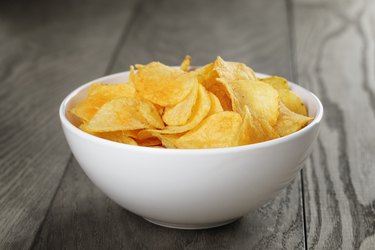
Being covered in itchy red bumps is not anybody's idea of a good time, but even with the advent of the chickenpox vaccine, cases do still crop up. While most common in children under 12, this virus can also affect adults, sometimes with serious results.
There is no specific diet for chickenpox, so once you have been diagnosed, all you can do is treat the itches topically and ride it out. Still, there are certain foods you might want to avoid, and a few comfort foods that may help you get through it.
Video of the Day
Video of the Day
Basic Facts About Chickenpox
Chickenpox is caused by the varicella-zoster virus, or VZV, explain the health experts at the Mayo Clinic. Before the development of a vaccine, it was rare for a person to reach adulthood without having contracted chickenpox. The first visible sign of chickenpox is the clusters of little red blisters that manifest on your torso, arms, legs and face. While they usually appear in kids 15 years old and younger, adults can also get them.
Chickenpox usually starts with headache, stomachache and/or sore throat, all of which can be accompanied by a low fever in the 101 to 102 degree F or 38.3 to 38.8 degree C range, according to Brenner Children's Hospital. These symptoms can present one at a time or all at once, and can last for several days. The rash of blisters can appear at any time, with or without other symptoms.
The fluid-filled blisters are often itchy, and since they can appear inside of your mouth, putting together a chickenpox diet, especially for a young child, can be a challenge.
Read more: Stages of Chicken Pox
Foods to Avoid With Chickenpox
The main concern as far as food to eat during chickenpox is the blisters that may form inside of the mouth. These can be very sensitive, so it is best to avoid salty foods; those that are crunchy and dry, such as pretzels and chips; very spicy foods; and acidic foods, such as pineapple or citrus juices.
According to the caregivers at ACC Adult Home Care, it may also be helpful to avoid foods that are high in L-arginine, an amino acid that viruses love to feed on. While there is no real proof that L-arginine makes chickenpox last longer or worsens its effects, avoiding foods that contain high levels of it will not hurt you.
Foods high in L-arginine include most types of shellfish, along with nuts, seeds and spinach — most of which will probably not appeal to a child who is not feeling well and so will be fairly easy to avoid.
Read more: What Are the Dangers of L-Arginine?
Best Foods During Chickenpox
The best foods for chickenpox are bland, comforting foods. Mashed potatoes are easy to eat and provide carbohydrates for energy. Chicken noodle soup is soothing and easy to chew if you either mince the chicken meat or leave it out altogether. Yogurt is cooling to an itchy mouth, as is ice cream.
It is also important to drink plenty of liquids, advise the experts at WebMD. Juices, broth and water are better than sugary drinks or diet soda. Teas and herbal tisanes are good for adults, and it is fine to include milk in chickenpox meal plans for both adults and children.
If your child has an upset stomach, you can keep her on the BRAT diet for a day or two. This consists of bananas, rice, applesauce and toast, all of which contain a type of binding fiber that is particularly gentle on the digestive system.
Read more: What Do You Give a Sick Kid Who Won't Eat?
Is this an emergency? If you are experiencing serious medical symptoms, please see the National Library of Medicine’s list of signs you need emergency medical attention or call 911.